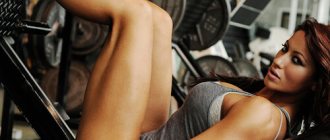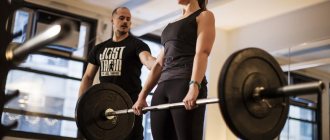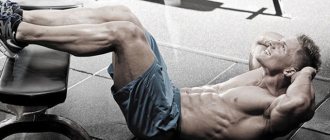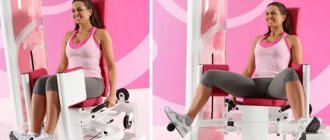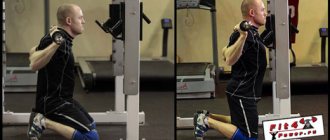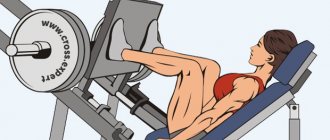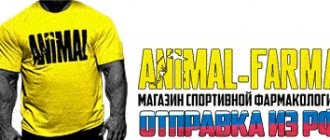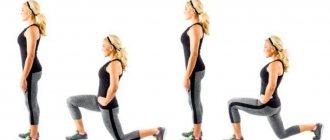The machine calf curl is a simple isolation exercise for the hamstrings. The person brings the heel to the buttock by contracting the biceps femoris and lowers the leg to the starting position. This exercise is performed by both beginners and those who have been involved in bodybuilding for a long time. The movement exists in a variant when the athlete lies face down on a bench, and when he performs a standing curl, bringing the heel of one leg towards the buttock. In classical training, there is a replacement - bending both legs with a dumbbell while lying down.
Execution technique
Initial position
- Much depends on the height of the athlete and the length of the bench of the machine, as well as on the position of the fixation cushion. It must be installed so that it is possible to start with “soft”, slightly bent knees, and so that the athlete can bring his heels to his buttocks without any problems;
- The support cushion should not roll onto the heel itself during movement, but should be located on the bend, in the area of the Achilles tendon;
- The weight is set depending on the experience and strength of the athlete, there is no need to set too much weight, this is not a movement to develop strength;
- To take the starting position, you need to lie face down on the bench and rest your feet on the exercise pad.
Movement
- It is enough to bend your knees so that your heels begin to move towards your buttocks, and bend your knees;
- The movement continues exactly until the heels rest on the buttocks, or until the volume of the hips and legs allows;
- At the peak of the amplitude, the biceps of the thigh are slightly tensed, and then the thigh is extended and the legs are lowered;
- The number of repetitions of the movement is from 10 to 20 or more, if necessary according to the athlete's training plan.
Attention
- Some lifters allow their hamstrings to rest during this exercise by extending their legs fully and popping their knees into a position that is typical for a deadlift. It is necessary to ensure that the tiles of the safety stops do not touch each other and that the exercise is performed with almost constant tone of the working muscle;
- The knee can and should be protected from injury if the athlete does not rest his kneecap on the pad of the exercise machine;
- There is no need to create a “swing” of the pelvis, an inertial movement that will contribute to hyperextension of the knee ligaments and injuries, and also take part of the load from the hamstring biceps;
- It is not recommended to actively move your ankles along and across the pad of the exercise machine. Such movements will contribute to Achilles tendon injuries;
- Activation of the hamstrings is possible without unnecessary movements, which many make, as if straightening their knees. This version of the exercise is quite traumatic for the ligaments, so it is not necessary to perform it.
It's the LYING LEG CURL, baby!
Recommendations
- Watch your body position on the bench. It is most convenient to bend your legs if the hip joint is on the “high” part of the bench, that is, on the place where it is highest;
- Do not push the pillow with your heels, and do not fidget on the bench;
- Try not to push your knees into hyperextension;
- Don’t struggle with weights, and don’t overload yourself with isolation exercises in general;
- If you use drop sets, make sure that the technique does not change as you get tired, and that your knees do not rest on the bench;
- Do not “drop” the weight so that the tiles of the machine hit each other;
- Do not lift the weight with your back, avoid excessively engaging the buttocks, this is not an exercise for them
TYPES OF LEG BENDING
Standing leg curl
Perfectly works the very bottom of the back of the thigh and the top of the calf muscle.
The body should be slightly tilted forward, the leg lifting occurs to the extent that the shin is slightly above parallel to the floor (but the roller does not touch the body), at the lower point the leg is slightly bent to maintain the load. It is important that if your body leans back when lifting, reduce the weight and perform the exercise with perfect form.
Leg bending while sitting in a machine
To begin, adjust the machine to the length of your hips and height; your knees should not go beyond the bench.
The lower back and center of the back are pressed tightly against the back, lower the bolsters so that your shins at the lowest point are strictly parallel to the floor, do not place them behind the machine.
Options
- Lying one leg bend . This variation is needed purely for variety, if, for example, the client gets tired of doing the same program all the time, and he needs something to make his life more interesting. The single leg curl is not very helpful, although it can help with injuries where you need to add extra weight to one leg;
- Standing bending . It can be performed in a special simulator or in a standard one. There is an opinion that this way the hamstrings contract more;
- Bend your toes in and out . Some bodybuilders believe that moving the toes in and out shifts the emphasis from the outer to the inner segment of the hamstrings. In fact, the knees do not allow this “operation” to be performed efficiently.
Technique for performing one-leg curls in a lying simulator
If you're trying to correct hamstring asymmetry or put more stress on the muscle, you can perform single-leg curls. In the first case, you can first perform the exercise with one leg, then shift the weight and repeat on the other. In the second, you can do bending alternately.
When bending one leg in the simulator, it is possible to make the hamstrings as symmetrical as possible.
The technique is the same as in the previous case. You can do the required number of repetitions first with one leg and then the other, or perform the lifts one at a time.
This exercise can also be performed standing. As shown below in the video excerpt.
An analogue of the exercise bending one leg while lying down is bending the leg while standing.
Analysis of the exercise
Anatomy exercises
What muscles work:
- The main mover is the thigh biceps; The popliteal, calf, and gluteal muscles help with movement. But in the version of working in simulators, the help of non-major muscle groups is minimal;
Benefits of Exercise
- Allows you to form a beautiful back surface of the thigh, works not only the biceps of the thigh as a whole, but also forms a beautiful “peak of the biceps”;
- Allows you to work with both one leg and two legs, ideal for those who have imbalances in muscle development;
- Training the hamstrings is necessary for those bodybuilders who avoid deadlifts and concentrate on squats. Bending will help protect the knees from injury due to uneven muscle development;
- It is convenient to pump the hamstrings on a bench with a “kink”; it allows you to reach a more stretched position and increase the amplitude, without increasing the load on the knee, and without overloading the cruciate ligament;
- The simulator allows you to achieve perfectly symmetrical muscle development
Flaws
- Sometimes athletes get their heels too low on the pad and their hamstrings are not isolated enough. In such a situation, it turns out that the calves become clogged and fail earlier than the hamstrings.
FITNESS. Video lesson “Lying leg curls in a simulator.”
Target muscles of the exercise: brief anatomical information
Many new girls in the gym spend a lot of time working on this machine, mistakenly believing that leg curls work the gluteal muscles. Yes, there is a slight load on the buttocks, but for the most part the exercise is performed by the biceps femoris, and this is precisely the muscle that many women try not to hypertrophy, so as not to get too voluminous thighs.
Muscles working during the lying leg curl exercise.
- The hamstrings bear the greatest load;
- The internal muscles of the thigh also help - semitendinosus and semimembranosus;
- In addition, the calf muscle is included in the work, which helps bend the leg at the knee.
Confusion with reverse hyperextension
Where did the opinion come from that bending and extending your legs on a machine is a great way to pump up your buttocks? The point, most likely, is confusion with another exercise: if we do not bend, but raise straight legs from a position lying on our stomach, then the buttocks will be involved in the work to the maximum. This exercise is called “reverse hyperextension.” Don't confuse these exercises: the first isolates the hamstrings, while the second works the hamstrings, glutes, and lower back.
Reverse hyperextension works well not only the hamstrings, but also the buttocks and back. And leg curls only isolate the hamstrings.
Preparing for the exercise
Some athletes really like to write about preparing for this exercise; they include hamstring stretching, some “warm-up” exercises, etc. in the program. In practice, all this is not necessary. Isolation movements are performed after basic exercises. Usually the muscles are already sufficiently filled with blood and elastic to allow the movement to be performed efficiently.
In fact, if this is the first exercise in the plan for some reason, it is worth including a stepper during your cardio warm-up, and starting with light weights during work. Most curling machines have an adjustable pad that we rest our feet on. It should be adjusted carefully enough so that the calf muscles do not become clogged during movement. This problem is the main reason why most athletes fail to benefit from movement.
Proper execution
- It is not allowed to bend the legs at the knee by lifting the pelvis. This option will be quite harmful, as it can lead to lower back injury if the angle in the joint is disturbed. Usually, if there is a strong lift of the pelvis, it is recommended to reduce the load and remove excess weight;
- You should not sharply push the exercise pad up and lift the weight due to inertia. Untrained knee ligaments can be injured if you work unevenly, and many machines are designed to transfer the load from an unevenly moving cable to the knee;
- You should slowly bend your legs, hold in the peak contraction, and just as smoothly straighten your legs in order to get a load and not get injured;
- If you cannot work smoothly, concentrating flexion on exhalation, it is recommended to remove the load and work with less resistance from the machine;
- It is better not to rest the kneecap on the exercise machine bench, if there is such a constructive possibility;
- The feet must be kept parallel to each other and not rotated with the toes during the exercise. It is ideal if the athlete does not maintain the distance between the knees while performing the exercise.
Errors
- You cannot rest your knees on the bench;
- It is not allowed to push the weight in jerks;
- If the training plan does not provide for this, movement at a reduced amplitude is not recommended;
- It is better to avoid actively involving your hands in the work, do not “cling” with them to the handles of the simulator;
- Do not lift your pelvis when working
Practical recommendations
The exercise is not a difficult one, but there are still a few nuances that are worth paying attention to.
- If you have bad knees, this exercise may increase your symptoms. It is better to neglect it or work with light weight.
- Do not straighten your legs completely and sharply at the bottom, as this can lead to knee injury.
- To prevent your knees from getting hurt, they should not be on the bench itself, but slightly hanging down.
- Do not lift your pelvis off the bench, this can injure your back.
- For prone bending, a machine with a curved rather than a horizontal bench is better suited: it reduces the load on the knees and allows you to increase the amplitude of muscle contraction-extension, making the exercise more effective.
- If you feel that your back is tired after doing it, it means that something has been broken in the technique.
Lying leg curls in a machine are a useful, but not universal exercise. You should not abuse it if you do not set yourself the goal of additionally pumping up the back of the thigh. Remember that it works in many other exercises, and often does not require intense additional impact.
Adviсe
- Avoid “ballet foot”, that is, stretching the toe forward and, as it were, pushing it away from the center of the arch of the foot;
- It is not recommended to perform work by hyperextending the femoral biceps and “reverse” extension in the knee joint. But if possible, it is better to work on a machine with a bench with a “kink” on which you should rest your hip joint;
- Toes point towards the foot
Variations of leg exercises
Classes with a fitness trainer
Shin flexion can be performed not only while lying down, but also while sitting. An extension machine is suitable for this, but the feet must be placed over the roller. And if you vary the positions of your feet, you can emphasize the load on different areas:
- heels together, toes out: outer thigh;
- straight feet parallel to each other: inner side.
The sitting position is less effective and will not bring quick results. However, not all gyms can offer a sufficient number of exercise equipment. It is also worth remembering that with this version of leg curl it is necessary to more accurately control the weight and range of motion.
If you overload or do not follow the technique, it is easy to injure the knee joint.
But in this position, chest excursions are more physiological, and breathing is freer.
Also, thanks to the sitting position, the inner part of the hamstring receives more stress and is better stretched. This exercise can be performed either with each leg in turn or with a dumbbell.
Inclusion in the program
This movement should not be a stand-alone exercise on leg day, and it should not replace the base, as well as some of the rows performed with a hyperextended hamstring. The movement should be done after basic hamstring exercises on the appropriate day if the athlete is splitting leg day.
The exercise can be performed for 10-12 repetitions, or for more. It all depends on the individual muscle response. In strength disciplines, this movement is not performed in more than 3-4 sets of 10 repetitions. In bodybuilding, other options are possible. Some athletes perform overload-style movements, use drop sets, and various other techniques to increase the intensity of the load.
Benefits of Isolated Calf Curl
Exercises without a simulator
All muscles that are involved in this exercise can be divided into three groups:
- hamstring - thigh biceps;
- synergists (working unidirectionally) - gastrocnemius, sartorius, thin and popliteal;
- antagonists (perform the opposite effect) or stabilizers - rectus muscle, tibialis.
This way you can pump the back of the thigh in isolation or focus on the middle part. Regular practice will quickly make your legs sculpted and lean, and increase working weights.
It is important that flexion and extension of the lower leg in a lying machine can be performed even while recovering a damaged knee. Correct technique will not only prevent re-injury, but also improve trophism of the knee joint and meniscus.
Isolated exercises are best combined with basic exercises.
This way you can load all muscle groups evenly and not be afraid of “overworking” in any one place. Harmonious development of the body is one of the main tasks of the gym and a competent trainer.
Contraindications
- This movement is not suitable for some athletes due to anthropometry. They can only do it with their knees resting on the bench due to their short stature. These people should switch to standing bending;
- You should not perform the exercise if you have recently had a knee injury, or there is a high risk that the soft tissue around the joint will become inflamed due to overuse;
- This exercise should not be performed when the piriformis muscle is cramping (this is a condition where pain in the buttock radiates to the leg after performing deadlifts), then the movement will almost certainly be due to the lifting of the pelvis, and the lifter will not receive the necessary load on the hamstrings;
- Movement is not recommended for Achilles tendon and ankle injuries;
- It is best to avoid if there is injury to the lumbar spine.
Features and Benefits
The technique for performing this exercise is extremely simple. The student is only required to take the required position on the machine, and then, with a controlled movement, lift the roller or pillow to the buttocks and lower it. Despite its simplicity, it has many advantages:
- Formation of muscle peak and relief. Therefore, it is suitable for both men and girls. You just need to choose the right weight to ensure the desired result.
- Ability to work in isolation - with the right and left legs separately. This allows you to eliminate asymmetry, if any.
- Minimum load on joints and ligaments. All of it falls on the muscles, it is almost impossible to get injured.
- Increased amplitude without increasing the load on the knees. The muscle gradually stretches, which is useful for those who want to increase volume.
Leg bending on a machine has very few contraindications:
- Incompletely healed injuries to the hamstrings, cruciate ligaments, knee joints, Achilles tendons, and ankles.
- Injuries to the lumbar spine.
- Piriformis muscle spasms (when performing exercises that require stretching the gluteal muscles, such as deadlifts, a sharp pain radiates to the thigh).
The main feature is that the exercise is not suitable for everyone. Those who are short in stature simply cannot take the correct position when lying on a bench, resting their knees on it; those who are tall, when performing a seated bending, grab the pillow with their calves, as a result of which the calf muscles become clogged before the thighs. The most universal option is a standing position.
It is not recommended to perform the exercise with very large, extreme weights. What is more important here is the number of repetitions that are pure in technique, allowing you to load and stretch the muscles.
Leg curls are a highly effective isolation exercise for the hamstrings.
Its essence is to bring the heels to the buttocks by contracting the biceps femoris muscle
Leg curl machines come in different types: you can do them while sitting, standing or lying down
Interesting Facts
- According to scientific research, it turns out that turning your toes still matters
- When you turn your toes to the side, it turns out that the outer sides of the thigh receive more load;
- If you connect your socks, the inner thigh will receive more stress
- Ronnie Coleman believed that this movement was great for developing massive thighs. But it should not be performed as the first movement, but only after lunges, squats, and Romanian deadlifts. You should do this exercise exclusively at the end of your workout.
Coleman advised doing this movement at the end of the workout, for 12-15 repetitions in 3-4 sets.
Essence and basic principles
The basic principles of any athletic exercise aimed at developing a group of muscle fibers come from the basic functions of the muscle, its attachment points and its size.
The quadriceps muscle is one of the largest muscles in the human body. It is located on the front surface of the femur. Each of the 4 heads of the group has its own beginning. But in the lower part they are all attached to a common large tendon. It wraps around the kneecap and attaches to the tibia.
The rectus femoris muscle is the longest in this group. It originates from the anterior inferior spine of the supraacetabular groove. The medial muscle occupies a middle position in the lower part. Attached to the medial lip of the linea aspera of the femur. In trained athletes, it looks like a drop hanging over the knee.
The vastus lateralis muscle occupies almost the entire outer surface of the upper limb. It originates from the greater trochanter of the intertrochanteric line and from the insertion point of the medial muscle. The vastus intermedius muscle is located on the front surface of the leg between the medial and lateral heads.
It is the weakest muscle bundle in the group and at the upper point is attached to the anterior surface of the femur. From this it becomes clear that the main function of the quadriceps is to extend the lower leg at the knee joint. Since the rectus muscle enters the posterior plane of the limb at its attachment point, when contracted it helps to bring the thigh to the ilium (hip flexion).
Thus, the essence of leg extensions in the simulator comes down to straightening the limb at the knee joint. However, the human body has a number of features that limit the range of motion in this exercise. They also impose a number of restrictions on the technique of execution. The leg extension machine is a chair with a hinged bolster at the base.
It is designed to transfer the load from the block mechanism to the target muscle group. More expensive equipment models are equipped with additional adjustments in the area of the rear backrest and lower cushion of the equipment. The support roller can be adjusted in height. This allows the athlete to get into the correct position before starting the workout.
Extension of the legs in a sitting simulator should be carried out taking into account the features of the equipment and the rules of technique for performing the movement:
- When sitting in a simulator chair, you must monitor the position of your pelvis. The athlete's buttocks should be pressed firmly against the seat cushion. Excessive hip extension is not allowed when performing the exercise. To avoid this, you should move the back of the chair so that the upper part of the limb lies completely on the surface of the pillow. At the same time, the lower leg should not touch the seat at the lowest point. Otherwise, the athlete will experience discomfort during the extension process.
- The support roller should be adjusted so that at the top point of the amplitude it approaches the ankle joint as closely as possible and even rests slightly on the foot. This will allow you to achieve maximum load at the moment of peak quadriceps contraction.
- Before starting the movement, you need to pull the toes of your feet towards you and maintain this position during each repetition.
When performing extensions in the simulator, sudden movements should be avoided. Jerking and throwing loads can cause injury to the athlete. This could be an injury to the back, inner or front thigh. Despite the fact that the quadriceps leg straightening is classified as an isolated exercise, it is aimed at developing a strong muscle group.
Consequently, the weight used can reach 40-60 kg even for beginner athletes. Given the high level of potential load, the athlete must understand the dangers that arise in this regard. The most acute risk of injury occurs when the leg is bent excessively at the knee.
This mistake is typical for beginners and experienced gym visitors. To reduce the risk when performing the negative phase of the movement, it is recommended not to lower the load below 90 g. from the plane of the seat cushion or do not allow the angle between the thigh and lower leg to be less than 90 degrees.
Alternatives
- If you go to the gym without a leg curl machine, you can act like the old school athletes. You need to use dumbbell leg curls while lying face down;
- The load can be simulated on the lower block of the crossover, then the leg can be alternately fastened to the lower block using a cuff;
- The third option, which is suitable for beginners and people who should not overload their hips, is to work with a fitness band. It is secured to a furniture leg, or some other vertical support, and draped over the foot so that it does not slip. Next, you need to perform bending with an elastic band while standing to get the active involvement of the thigh muscles in the work;
- The easiest option is a standing leg curl with ankle weights. It is performed standing on a steppe or other support. It is suitable only for completely beginner athletes, for whom this weight will be enough;
- Training for beginners also involves performing bending while lying face down with weighted cuffs. You can do this movement one leg at a time, wearing several fitness weights on each leg.
Leg curls are a good isolation exercise for the hamstrings. For most people, a simple rule works - you need to perform as many flexions as extensions. But if an athlete has too developed quadriceps, he should focus on bending his legs.
Errors and technique for performing lying leg curls
Igor April 18, 2019
Advantages and disadvantages
The lying leg curl machine is used very often when training the leg muscles. Moreover, both among ordinary gym goers and professional bodybuilders.
This fact speaks about the obvious advantages of the exercise:
- Suitable for isolated pumping of the hamstrings
- A given structure and amplitude of movement, which makes it easier to perform and is suitable even for beginners
- Can be used both in training to increase muscle volume, and in relief training
- Relatively low risk of injury
Here, compression of the spine is almost completely eliminated, and the load on the working ligaments is minimal.
However, leg curls also have a number of disadvantages:
- Contributes to the growth of muscle mass and strength to a lesser extent compared to basic exercises
- May not be suitable for people with spinal problems
As strange as it may sound, the lying leg curl block is potentially dangerous for the lower back. But this only applies to people with an already unhealthy spine. For example, with hernias or protrusions.
As soon as the technique is broken, the risk of negative effects on the lower back increases.
The exercise may also be uncomfortable during exacerbations of back problems.
Benefits of Exercise
The lying leg curl exercise has many positive properties and benefits. The main point is that the exercise is one hundred percent isolated, i.e. is aimed at developing a specific muscle group, which in this case includes the back surface of the legs.
In addition, the exercise can be effectively used to work on the relief of the hamstrings and gluteal muscles. To do this, you should reduce the weight of the weight on the machine and increase the number of repetitions in the approaches.
Performing the exercise also has other benefits:
- The simplicity of performing the exercise, in which even novice athletes can master its correct technique;
- Variety of load shifting options;
- Increasing strength in basic exercises that involve the hamstrings and gluteal muscles (barbell squats, deadlifts);
- Allows you to work the transition area between the gluteal muscles and hamstrings;
Many athletes, especially men, do not pay enough attention to lying leg curls, but the exercise is really very effective. Developed hamstrings and gluteal muscles provide harmony and correct relationship between the front and back of the leg
This is important both from an aesthetic point of view and from the position of significantly reducing the risk of injury, which often occurs due to the lag of some muscles from others.
Technique for performing lying leg curls:
- Adjust the machine's lever to match the length of your legs and lie face down on the machine's bench. Your feet are positioned under the machine's bolster with a pad on the back of your legs (just a few inches below your shins). Tip: It is preferable to use a leg curl machine that is angled as opposed to flat, as the angled position is more anatomically favorable for curling.
- Keep your torso flat on the bench, make sure your legs are fully extended, and hold onto the side handles of the machine. Place your feet straight (or you can also use either of the other two foot positions described in the foot positioning section). This is your starting position.
- As you inhale, lift your legs up as far as possible without lifting your hips off the bench. Once you have fully bent your legs, maintain a peak contraction of your thigh muscles in this position for 1-2 seconds.
- As you exhale, slowly lower your legs back to the starting position. Repeat these steps for the recommended number of repetitions.
Caution: Never use excessive weight on the lying leg curl exercise when you begin using rocking and twitching exercises as this may create a risk of both lower back and hamstring injuries.
Tips for implementation
In order for the exercise to be most effective, it is recommended to follow the following recommendations:
- When bending your legs, firmly hold the handles of the machine to eliminate unnecessary unwanted movements of the spine.
- Do not lift your body off the machine bench. When performing the exercise, you should feel the muscles of the thigh, not the lower back, working.
- Try to bend at maximum amplitude, bringing your legs almost to touch your buttocks.
- Maintain tension in your legs while lowering the weight, do not straighten your knee joints completely, otherwise the tension necessary for their full development will be removed from the hamstrings.
- Another tip is to make the leg curl a little faster than the lowering.
- Do not try to quickly lift your legs by jerking, thereby overcoming a difficult section of the climb. Perform the bends smoothly; if it is too difficult for you, reduce the weight of the load.
Execution options:
- The movement can also be performed with a dumbbell held between the legs (with a partner positioning it properly). This option is only suitable for experienced athletes.
- Finally, curls can also be performed using one leg at a time for even more isolation.
https://youtube.com/watch?v=mtuH16KHCuI
